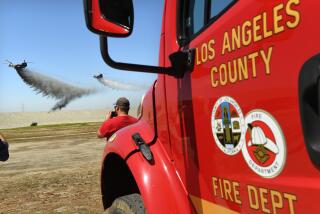Pesticide use rises, but farms shift to less harmful varieties
More pesticide was used on California farms last year than in previous years, but growers reduced their reliance on many of the most toxic compounds, according to state data released Wednesday.
State Department of Pesticide Regulation Director Mary-Ann Warmerdam said the increased use of less-toxic compounds “shows that we are moving in the right direction.”
In recent years, California growers have lost some of their chemical arsenal because of newly adopted state and federal rules. As a result, many have sought alternatives.
Many insecticides, herbicides and other pest-killing chemicals have been linked to cancer, neurological damage, birth defects or other reproductive effects. The greatest risk is for farmworkers, but some chemicals drift off fields, exposing neighbors.
Most commercial pesticides are applied in the San Joaquin Valley, the nation’s leading agricultural area, led by Fresno, Kern and Tulare counties. Ventura County -- which has more than 1 million acres of strawberry fields, lemon groves and other crops -- ranks eighth in pesticide use.
For California’s top dozen crops, which account for more than 80% of the pesticides used, 11.7 pounds were applied per acre in 2005, compared with 10 pounds the year before, according to the pesticide agency’s data. A total of 194 million pounds of all pesticides, an increase of 14 million from 2004, were used last year -- on average, 5 pounds for every resident of the state.
But use of many soil fumigants, carbamates and organophosphates -- considered the riskiest pesticides for farmworkers and neighbors -- declined. Volumes of reproductive toxins dropped 8.8% last year, while carcinogens dipped slightly, by 2.6%.
At the same time, use of compounds classified as “reduced risk” increased 60%, reaching about 630,000 pounds.
“It’s not the pounds per se, it’s pounds of what, and in most cases, there was increased use of less-toxic chemicals, and decreased use of chemicals such as fumigants,” said Glenn Brank, spokesman for the pesticide department.
Nevertheless, environmentalists are concerned that some dangerous chemicals are increasing and state restrictions are coming too slowly.
Susan Kegley, senior scientist of the San Francisco-based Pesticide Action Network of North America, said she gives California growers and the state pesticide department a C grade for progress made in 2005.
While the growth in less-toxic pesticides is “an important move into the future,” she said some “very toxic, very drift-prone chemicals” are used in California in large, increasing volumes.
Environmentalists are most concerned about fumigants, which are gases injected into the field before planting to sterilize the soil and destroy insects, weeds and diseases.
Total fumigants dropped slightly in volumes and acres treated last year, as they have for several years.
But one -- manufactured by Dow Chemical Co. and named Telone, or 1,3-dichloropropene -- is increasing “at a fairly alarming rate” and has been for 10 years, Kegley said. More than 9 million pounds were used in California in 2005, much of it on almonds, grapes, strawberries and carrots.
“Growers are not making progress toward using less-toxic alternatives for soil pests, and that’s a problem that needs to be addressed,” Kegley said.
Strawberry growers have been gradually weaning themselves off methyl bromide, a fumigant that is a potent neurotoxin and has been phased out under an international treaty because it depletes the ozone layer.
But many have switched to Telone, which has been linked to various cancers in animals and leukemia and lymphoma in highly exposed humans. It was banned statewide in 1990 because of high concentrations in Merced County air, then returned to use with new restrictions in 1995, after Dow conducted research on lowering air emissions.
Brank said California growers are “trying their best” to use the least toxic materials, but they are still struggling to find viable alternatives for fumigants.
“We saw that growers are switching from one to another, and that’s why we are taking some additional steps against fumigants,” he said. “We’re not standing still on fumigants, not anywhere close to that.”
California is about to impose the nation’s most stringent fumigant restrictions. The department’s proposal, expected to be unveiled before the end of the year, will probably focus on reducing pounds of fumigants used per acre by requiring larger buffer zones around fields, use of better tarps and lower application rates per acre.
The U.S. Environmental Protection Agency also is in the process of reviewing all fumigants as a step toward possible national restrictions.
Of the extra 14 million pounds of pesticides used in the state last year, much of it was sulfur, a natural fungicide applied as a dust on vineyards and orchards.
Because of a wet spring in 2005, growers of wine and table grapes and almonds needed more sulfur to kill mold and mildew. Used by organic as well as traditional growers, sulfur is California’s most abundant pesticide, accounting for one-third of all tons in the state.
Growers of other major crops -- including strawberries, rice and tomatoes -- reduced their total tons of pesticides last year.
Ventura County’s preliminary numbers showed that pesticide use dropped to 6.35 million pounds last year from 7.28 million in 2004.
*
(BEGIN TEXT OF INFOBOX)
By the numbers
Last year, California used fewer pounds of pesticides containing toxic chemicals than in 2004, while increasing the use of less-dangerous compounds.
--
8.8%...Decrease in chemicals classified as reproductive toxins
2.6%...Decrease in chemicals classified as carcinogens
60%...Increase in “reduced-risk” pesticides
--
Source: California Department of Pesticide Regulation
More to Read
Sign up for Essential California
The most important California stories and recommendations in your inbox every morning.
You may occasionally receive promotional content from the Los Angeles Times.










